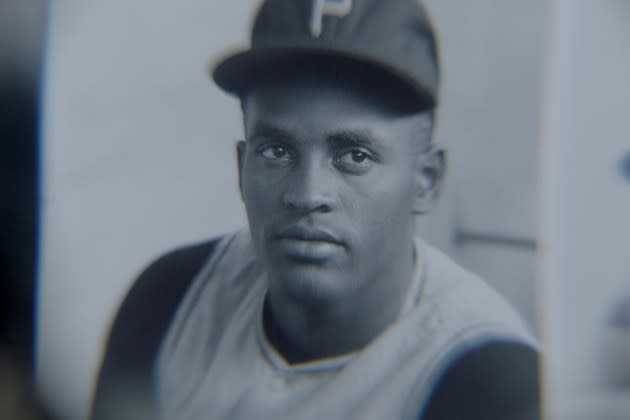‘Clemente’ Review: A Grounded and Emotional Documentary Tribute to a Legendary Athlete
- Oops!Something went wrong.Please try again later.
- Oops!Something went wrong.Please try again later.
- Oops!Something went wrong.Please try again later.

It’s possible to define the greatness of Pittsburgh Pirates right fielder Roberto Clemente with numbers.
Precisely 3,000 hits. Twelve Gold Gloves. Two World Series titles with a franchise that hadn’t won one in the 30 years before Clemente’s arrival. One World Series MVP and one National League MVP. The first Latino player to be inducted into the Hall of Fame in Cooperstown.
More from The Hollywood Reporter
'Cheech & Chong's Last Movie' Review: A Lively and Informative Look at the Duo, Then and Now
SXSW "Does Not Agree" With Texas Governor Telling Boycotting Artists "Don't Come Back"
The numbers for Roberto Clemente are fairly phenomenal.
But they’re inadequate.
Roberto Clemente is in a pantheon of sports figures because of the trail he blazed for Latino and specifically Caribbean players. He’s revered because his commitment to humanitarian causes was so all-encompassing that his death, at the age of 38, came while transporting supplies to earthquake victims in Nicaragua. He’s iconic because the things he did on the field that couldn’t always be measured statistically — his throwing arm, his on-field intensity — bordered on Bunyanesque.
David Altrogge’s documentary Clemente, which features Richard Linklater and LeBron James among its A-list executive producers, gives Clemente a long-overdue solo spotlight and finds a solid middle ground between straight-up hagiography and a slightly less reverential adulation that will make younger viewers understand why such affection could be warranted.
After quickly starting with Clemente’s 3,000th and final career hit, Altrogge sticks to a basic chronology in taking Clemente from his lower-middle-class upbringing in Puerto Rico through his signing with the Dodgers and then acquisition by the Pirates under the watch of Branch Rickey (yes, that Branch Rickey). From there, it’s on to Clemente’s arrival as a star in the 1960 season and World Series and then his explosion as a superstar for the next decade, fighting layers of societal and institutional prejudice along the way.
Even with Clemente’s brother Matino offering some texture, there’s an inevitable dryness to those early personal details that generally have to be related by biographers and historians, though Rita Moreno is present to add insight on her own transition from Puerto Rico to mainland stardom. The film is generally a good complement to Mariem Pérez Riera’s very fine Moreno documentary Just a Girl Who Decided to Go For It.
With actual footage of young Clemente at a premium, Altrogge turns to watercolor-style animation from Tandem Media to fill in the blanks with bursts of whimsy. The animation still pops up later for more personal recollections, but once the story gets into Clemente’s prime, there’s game film aplenty. If you’re a baseball fan, it’s impossible to ever tire of watching Roberto Clemente’s laser-guided throws or his deceptively ungainly running style. Or, as celebrity Pirates fan Michael Keaton puts it, “Did he know he looked that cool?”
Altrogge knows that some of those statistics for Clemente need to be discussed, but nobody’s heart is really in it. Probably the flimsiest piece of the entire 105-minute documentary is a brief discussion of Clemente’s apparent frustration at not winning the National League MVP in 1960. A few talking heads mention an out-of-context stat or two and make inferences as if it’s now obvious, through a modern lens, that Clemente finishing eighth could only be explained by voter prejudice. Through the modern lens of WAR (wins above replacement), Clemente might have actually finished too high. But numbers are inadequate! That’s the point. Don’t wallow.
What makes Clemente such a treasure for baseball fans, then, are the extensive interviews with his teammates, especially the players on the 1971 championship squad. It’s a wonderful group including Manny Sanguillen, Richie Hebner, Steve Blass, Al Oliver and more, each player sharing their respect and love for Clemente and offering this tangible proof that his “value” wasn’t related to homers or outfield assists. Several contemporary stars — Francisco Lindor, a couple of Molina brothers — add to the value-beyond-numbers debate, illustrating the trail that Clemente blazed for Latino athletes, though Altrogge could have steered even harder into his sociopolitical impact and influence.
Even better than these visitations from the Ghosts of Complete Topps Baseball Card Sets Past are the people who contextualize Clemente beyond the world of sports. Interviews with two of Clemente’s sons as well as his late wife Vera capture a man who was loving, dedicated and just a bit eccentric — a fight almost breaks out between two talking heads over whether or not Clemente was a hypochondriac — in a purely human way. And then there are several stories from ordinary Pirates fans (and the aforementioned Linklater), whose tales of seemingly casual interactions with this previously larger-than-life figure actually made me emotional.
Few documentary subgenres have been more burgeoning in the past couple of years than the sports doc, with Yogi Berra and Willie Mays getting very solid standalone films. If you’re a devotee, you can add Clemente to the ranks of the good ones.
Best of The Hollywood Reporter

